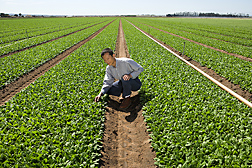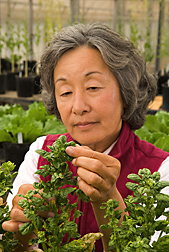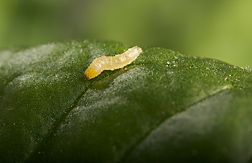Spinach
Protecting and Enhancing This Nutrition Superstar
|
|
With its attractive, dark-green leaves and big supply of good-for-you nutrients, spinach makes a pleasing, healthy accent to everything from a delectable feta-cheese omelet to an easy-to-make lasagna.
Perhaps best known as a source of iron, spinach also offers several other key nutrients. These include calcium, potassium, vitamins C, D, K, and B9 (folate)—as well as beta-carotene, a molecule our bodies use in making vitamin A.
Unfortunately, spinach is also a favorite of troublesome insects known as “leafminers,” says ARS plant geneticist Beiquan Mou. Adult leafminers—shiny black flies about one-tenth inch long—sport a bright-yellow triangle on their backs. They can ruin spinach, lettuce, and other salad greens when they puncture leaves to feed on the sap—creating bumpy, unsightly holes called “stings.”
Adult females cause additional damage by inserting their eggs between the upper and lower layers of a spinach leaf. The hungry, wormlike larvae that hatch from the tiny white eggs feed voraciously on the leaves. Their munching creates winding, whitish tunnels—the signature “mines” leafminers get their name from.
Undermining Miners
|
|
To help protect tomorrow’s spinach against leafminers, researcher Mou has developed two kinds of parent spinach plants with impressive natural resistance to the insect. In fact, these unique plants rate as the world’s first spinach breeding lines with significant leafminer resistance.
Mou has already made seeds of the plants, known as “03-04-09” and “03-04-63,” available to breeders and researchers worldwide. He is based at the ARS Crop Improvement and Protection Research Unit at Salinas, California.
The new spinach plants aren’t market ready. Instead, they serve as an invaluable source of resistance that can be bred into spinach types already popular with growers, home gardeners, and shoppers.
Natural resistance offers the most economical, effective, and Earth-friendly way to battle leafminers. That’s unlike a traditional option, chemical sprays, which can indeed clobber flying adults within a spinach field but must be applied again if other adults invade later on.
The parent spinach plants result from 3 years of rigorous field tests by Mou and colleagues. During their spinach search, they scrutinized hundreds of candidate plants, including every one of the more than 300 different kinds of spinach safeguarded at the ARS-curated collection at Ames, Iowa—America’s official spinach genebank.
Though the new plants aren’t resistant to the stings of the flying adult leafminers, they have many fewer mines than the other kinds of spinach tested, Mou says.
|
|
Foiling a Fungus
In new work, Mou has narrowed the field of candidates among spinach plants that are resistant to another natural foe—a fungus that causes the disease Stemphylium leaf spot. The fungus showed up for the first time in California spinach fields—where three-fourths of the nation’s spinach is grown—in 1997. It has also occurred in at least six other spinach-growing states.
“We don’t have an outbreak in every year,” notes Mou, “but we want to be prepared by doing the breeding now.”
The fungus causes tiny round or oval spots to form on leaves. As the disease progresses, the spots enlarge and change from gray-green to tan as they dry out, killing the leaf.
In the quest for a leaf-spot-resistant spinach, Mou has examined all the spinach specimens from the genebank and others provided to him by vegetable seed companies internationally. He and collaborators Steven T. Koike of the University of California-Davis and Lindsey J. du Toit of Washington State University-Pullman, have now narrowed the field of candidates from hundreds to about a half-dozen.
|
|
Sizing Up Spinach’s Vitamin A Payload
Meanwhile, other scientists have taken a closer look at spinach’s bountiful supply of beta-carotene to determine, with precision, how much of it is actually converted to vitamin A in our bodies.
The United States doesn’t have the severe vitamin A deficiency that is rampant in many developing nations. Nevertheless, an estimated 4 in 10 Americans don’t get adequate amounts of vitamin A from foods.
Guangwen Tang of the ARS Jean Mayer Human Nutrition Research Center on Aging at Tufts University, Boston, Massachusetts, and Michael A. Grusak, a plant physiologist at the ARS Children’s Nutrition Research Center, Houston, Texas, collaborated in the study of 14 healthy, nonsmoking volunteers, aged 45 to 72.
The volunteers ate spinach purée that contained a safe, natural, edible tracer that Tang and her Tufts colleagues could detect in blood samples. The tracer made it possible for the researchers to estimate the amount of vitamin A that the volunteers were able to make from the beta-carotene provided in the spinach.
“On average, for every 20 milligrams of beta-carotene from spinach, volunteers were able to make about 1 milligram of vitamin A,” Tang reports. Though this is lower than the previously estimated 12-to-1 ratio, “spinach is still a good source of beta-carotene,” she says.
The study is the most exacting, to date, of bioconversion of spinach’s beta-carotene into vitamin A in healthy people. The findings are of use to the nutrition and healthcare professionals who set guidelines for what we need to eat—in America—to get enough vitamin A. The research should also help public health officials who are seeking solutions to vitamin A deficiency globally. Colorful fruits and vegetables that are rich in beta-carotene “could help reduce vitamin A deficiency in parts of the world where this is truly a problem,” says Grusak.
Tang, Grusak, and Tufts coinvestigators Gregory G. Dolnikowski, Jian Qin, and Robert M. Russell documented their findings in a 2005 issue of the American Journal of Clinical Nutrition.—By Marcia Wood and Alfredo Flores, Agricultural Research Service Information Staff.
This research is part of Genetic Resources, Genomics, and Genetic Improvement (#301), Plant Diseases (#303), and Human Nutrition (#107), three ARS national programs described on the World Wide Web at www.nps.ars.usda.gov.
To reach scientists mentioned in this article, contact Marcia Wood, USDA-ARS Information Staff, 5601 Sunnyside Ave., Beltsville, MD 20705-5129; phone (301) 504-1662, fax (301) 504-1486.
"Spinach: Protecting and Enhancing This Nutrition Superstar" was published in the October 2007 issue of Agricultural Research magazine.










